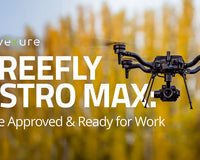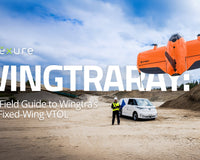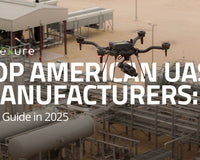As a code enforcement officer, you’re called to inspect a large, remote property with reports of excessive vegetation—suspected to be an illegal, unlicensed cannabis grow operation. While the property owner has a history of confrontational behavior, you need evidence to confirm the presence of cannabis plants before taking further steps.
This is where a drone, or unmanned aerial system (UAS), can offer a practical solution. By providing a safe and unobtrusive way to inspect hard-to-access areas, drones allow you to collect crucial evidence without setting foot on the property.
That said, flying a drone isn’t without legal and regulatory considerations. To help code teams use drones responsibly, this article explores how drones are supporting code enforcement teams, provides real-world examples, and outlines key steps and guidelines for starting a compliant drone program tailored to your city’s needs.
Why Use Drones for Code Enforcement?

Drones are quickly becoming practical tools for handling complex code enforcement tasks, especially when properties are difficult to access or require detailed documentation. Here are six areas where drones are proving valuable in code enforcement:
1. Illegal Cannabis Grow Operations
One of the top challenges code enforcement officers face is identifying unlicensed cannabis grow operations. With certain states having strict licensing requirements, drones provide an efficient way to survey large rural properties and detect suspicious activity from a safe distance, allowing officers to identify and address illegal growers without direct confrontation.
2. Nuisance and Blight Abatement
Drones are invaluable for monitoring and documenting nuisance or blighted properties, particularly for concerns like excessive vegetation growth, unapproved modifications to homes, and other ordinance violations. By capturing aerial footage, officers can effectively record conditions and gather necessary evidence to support enforcement actions.
3. Fireworks and Fire Hazard Abatement
In fire-prone areas, enforcing fireworks restrictions is a critical safety measure. Drones enable code enforcement officers to monitor neighborhoods during high-risk times, like holidays, when illegal fireworks are most common. With aerial surveillance, officers can spot offenders lighting fireworks in restricted areas, helping prevent potential fires and ensuring quick, accurate response.
4. Vendor Violations at Stadium Events
Drones provide code enforcement with a clear view of vendor activity around large stadium events, where unlicensed food trucks and vendors often camp outside venues. These operators undercut licensed vendors inside, violating local regulations and potentially posing health risks. Drones help officers document unlicensed activity, ensuring fair compliance with vendor regulations.
5. Reducing Direct Interaction with Property Owners
In Conway, Arkansas, drones help code enforcement officers gather visual evidence from a distance, improving safety and reducing the potential for conflict or escalation from the property owner.
How to Start a Code Enforcement Drone Program

For code enforcement teams considering the addition of drones, following a clear, structured approach is key. Here’s a guide to help departments get started effectively.
1. Assess Department Needs
Identify the specific tasks drones will support. Consider current challenges—such as inspecting hard-to-reach areas or documenting large properties—and evaluate how drones could add value. This assessment will clarify your department’s primary needs and shape the focus of your drone program.
2. Choose the Right Equipment
Select drones that meet your operational requirements. Drones with high-resolution cameras are ideal for detailed property inspections, while smaller, agile models may be better suited for navigating dense or cluttered spaces. Equipment choices should align with both budget and the tasks drones will perform.
3. Develop a Budget and Make the Case for Funding
Once you understand your equipment needs, outline a realistic budget that includes hardware, software, training, and maintenance. Presenting a strong case for funding often involves showing how drones improve safety, efficiency, and resource allocation. Speaking with other city departments with drone programs can give precedence for improvements in these areas, strengthening your case for support.
4. Develop a Training Plan
Training is critical for safe and effective drone use. Ensure selected team members complete the FAA’s Part 107 certification to be compliant and receive hands-on training. Tailor the training to code enforcement scenarios, including capturing footage for evidence and navigating property boundaries responsibly.
5. Create Operational Policies and Guidelines
Establish clear policies that outline how and when drones can be used. Consider regulations, such as adhering to FAA guidelines for altitude and airspace, as well as privacy considerations in residential areas. A well-defined policy framework not only ensures compliance but also builds trust within the community.
(Note: We’ll cover compliance and regulatory requirements in detail in the next section.)
6. Plan for Data Management and Evidence Collection
Drones collect large amounts of visual data, so establish protocols for storing, reviewing, and securing footage. Ensure data management practices comply with department standards for handling evidence, and outline procedures for sharing drone footage with other city departments if needed.
Legal and Regulatory Considerations for Drone Use
Using drones in code enforcement brings specific legal and regulatory responsibilities, especially regarding privacy and compliance. Here are key considerations and actionable steps for departments to ensure lawful drone usage.
1. Understand Privacy Implications and the Fourth Amendment
Privacy regulations, including Fourth Amendment restrictions, prohibit unreasonable searches, which is a key concern when using drones for inspections. To avoid infringing on privacy rights, code enforcement departments should consider if their aerial inspections may qualify as “searches” under legal standards. Case law provides some guidance:
- Katz v. United States established that a “reasonable expectation of privacy” determines whether a search has occurred. If this expectation exists, a warrant is often required (Katz v. United States, 1967).
- Plain View Doctrine: If a violation is in plain view from a public vantage point, it may be legally observed without a warrant. Drones, when used within navigable airspace, can often leverage this doctrine.
- Long Lake Twp. v. Maxon: In this Michigan case, the court emphasized the need for inspection warrants when drones are used for prolonged or detailed property inspections (Long Lake Twp. v. Maxon).
Action Step: Whenever possible, confirm compliance by observing violations from public areas. If in doubt, consult with your department’s legal team or consider obtaining an inspection warrant.
2. Obtain Necessary FAA Certifications and Waivers
All public agencies operating drones must comply with FAA guidelines. Two main pathways exist for drone certification, depending on the weight and purpose:
- Part 107 Certification: This applies to drones under 55 pounds for commercial and governmental use. Code enforcement staff piloting drones should complete the Part 107 certification, which involves passing an FAA exam (FAA Part 107 guide).
- While Advexure doesn't offer Part 107 training, we highly recommend the following resources:
- Certificate of Waiver or Authorization (COA): Agencies needing more flexibility can apply for a COA to self-certify drone pilots and bypass some Part 107 limitations (FAA COA resource).
Action Step: Determine which certification pathway fits your department’s needs, and ensure all operators have the required FAA certification. For more complex operations, a COA may be advisable.
3. Follow Guidelines for Public Airspace Use
To comply with FAA regulations, drones must operate within public navigable airspace, typically below 400 feet. Adhering to this altitude ensures compliance and minimizes risk of privacy intrusion
Action Step: Establish altitude limits within your department’s operational policies to ensure all flights remain within regulated airspace. When appropriate, provide additional guidance on minimizing flights over private areas to avoid privacy concerns.
4. Set Clear Departmental Policies on Data Use and Storage
Since drones capture visual data, departments should outline how footage will be stored, reviewed, and shared, ensuring privacy and security standards. For example, policies should specify who has access to footage and how long data is retained, particularly if used as evidence in enforcement actions (Civica Law Group’s guide to drone data policy).
Action Step: Draft a data management policy that details storage duration, access permissions, and secure disposal of data once it’s no longer needed.
5. Establish Community Transparency and Accountability
Implementing a drone program responsibly involves community awareness and trust. Consider publicly sharing information about how and when drones will be used to support enforcement, especially for residential inspections.
Action Step: Engage in transparent communication with the public to address privacy concerns. This might include public notices, community forums, or informational web pages that outline your department’s drone use policies and protections.
Selecting the Right Drone for Code Enforcement Tasks

DJI Mavic 3 Enterprise
The Mavic 3 Enterprise is a compact, highly portable solution ideal for quick and clear visual inspections. Its 56x hybrid zoom and powerful camera provide detailed imaging, making it a reliable choice for code enforcement tasks like assessing compliance from a safe distance.
Key Features:
- 45-minute maximum flight time
- High-resolution zoom camera (48 MP) for detailed visuals
- Compact, easy to deploy in seconds
- Great for mapping & photogrammetry
DJI Mavic 3 Thermal
Built for inspections in low-light or nighttime conditions, the Mavic 3 Thermal combines thermal imaging with a compact design, making it a practical tool for monitoring properties where heat sources or activity need to be detected. Its thermal camera can quickly spot temperature anomalies, assisting in cases where unauthorized occupancy or structural issues may be a concern.
Key Features:
- 45-minute maximum flight time
- 640x512 thermal camera for reliable heat detection
- Dual thermal and visual camera view for enhanced clarity
- High-temperature alerts and spot metering
- Rapid deployment for on-the-go inspections

DJI Mavic 3 Multispectral
The Mavic 3 Multispectral is designed to detect chlorophyll levels, making it especially valuable for code enforcement teams targeting illegal cannabis grow operations. Its multispectral imaging can identify cannabis plants hidden among other vegetation, helping officers distinguish regulated crops from concealed grows. Additionally, this drone supports environmental monitoring, detecting plant health and vegetation overgrowth to aid in broader environmental compliance efforts.
Key Features:
- 43-minute maximum flight time for extended operations
- Integrated multispectral and RGB cameras for precise vegetation analysis
- Compact design, easy to deploy in remote locations
- Multispectral imaging capabilities for identifying plant health and environmental concerns

DJI Matrice 30T
For larger inspection areas requiring extended flight times, the Matrice 30T is a robust solution. Equipped with a 48 MP zoom camera, thermal imaging, and a laser rangefinder, it offers the advanced features needed for comprehensive property surveys over wide areas.
Key Features:
- 55-minute maximum flight time
- Integrated thermal, zoom, and wide-angle cameras
- Laser rangefinder for precise location tracking
- Weatherproof design for challenging conditions
- Compatible with DJI FlightHub 2 for fleet management
DJI Mini 4 Pro
For departments new to drones or working with a limited budget, the DJI Mini 4 Pro is a compact, affordable choice. While it doesn’t have the advanced sensors of the other models, its high-quality camera and ease of use make it an excellent option for basic inspections and visual documentation. Its lightweight design also allows for easy deployment in various field conditions.
Key Features:
- 34-minute maximum flight time
- 48 MP camera for clear, high-resolution images
- Compact and ultra-portable, ideal for on-the-go inspections
- Obstacle sensing for added safety
Embracing the Future of Code Enforcement
Drones are rapidly proving their value as efficient, adaptable tools, helping departments conduct safer inspections, gather clear evidence, and enhance operational efficiency. With options tailored for specific needs—whether it’s multispectral imaging, extended flight time, or high-resolution visuals—drones can transform how code officers approach their work in the field.
For departments ready to explore these benefits, Advexure is here to support you every step of the way, from selecting the right equipment to developing a compliant drone program. Contact us today to learn more about how drones can elevate your capabilities.












